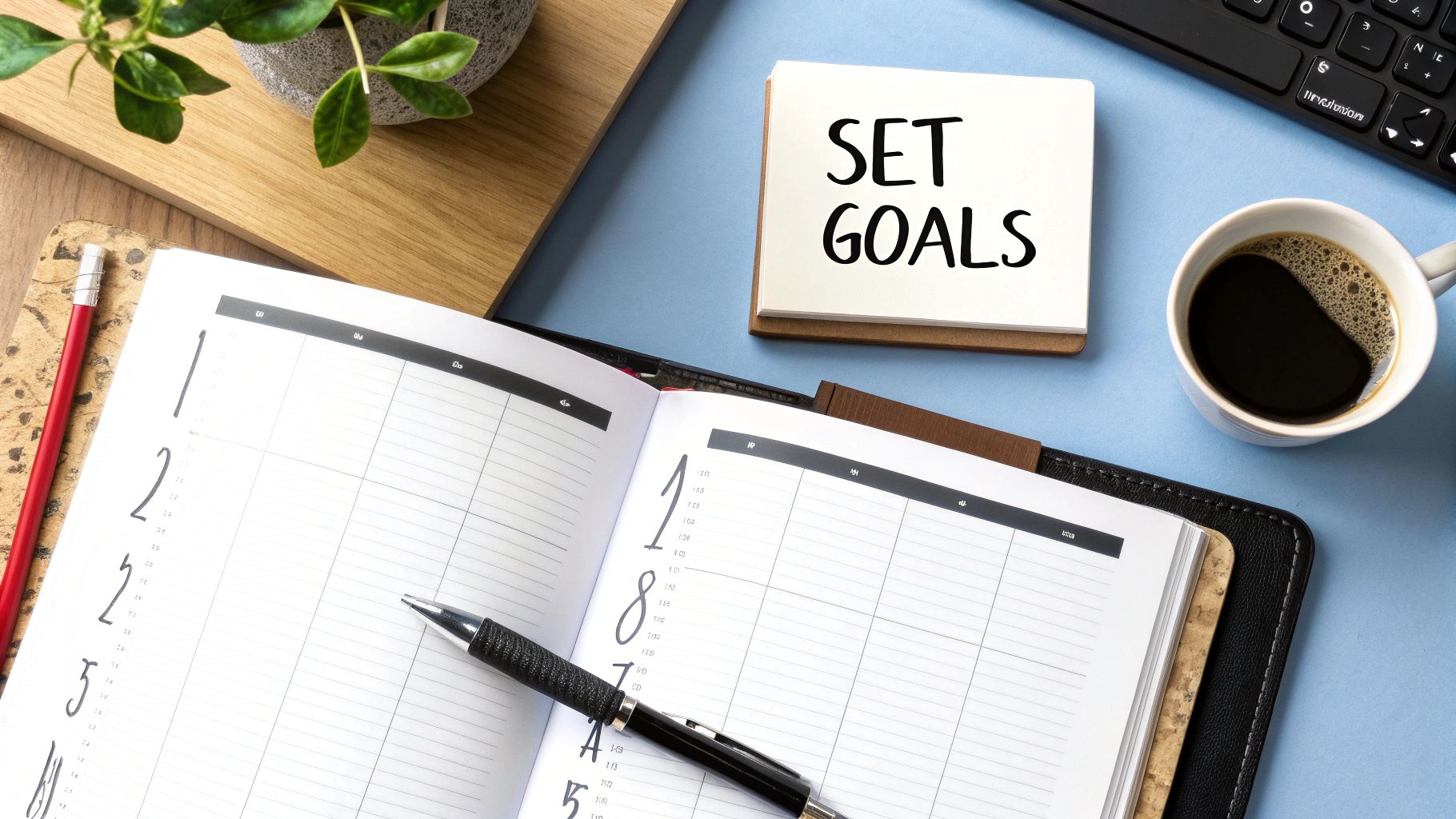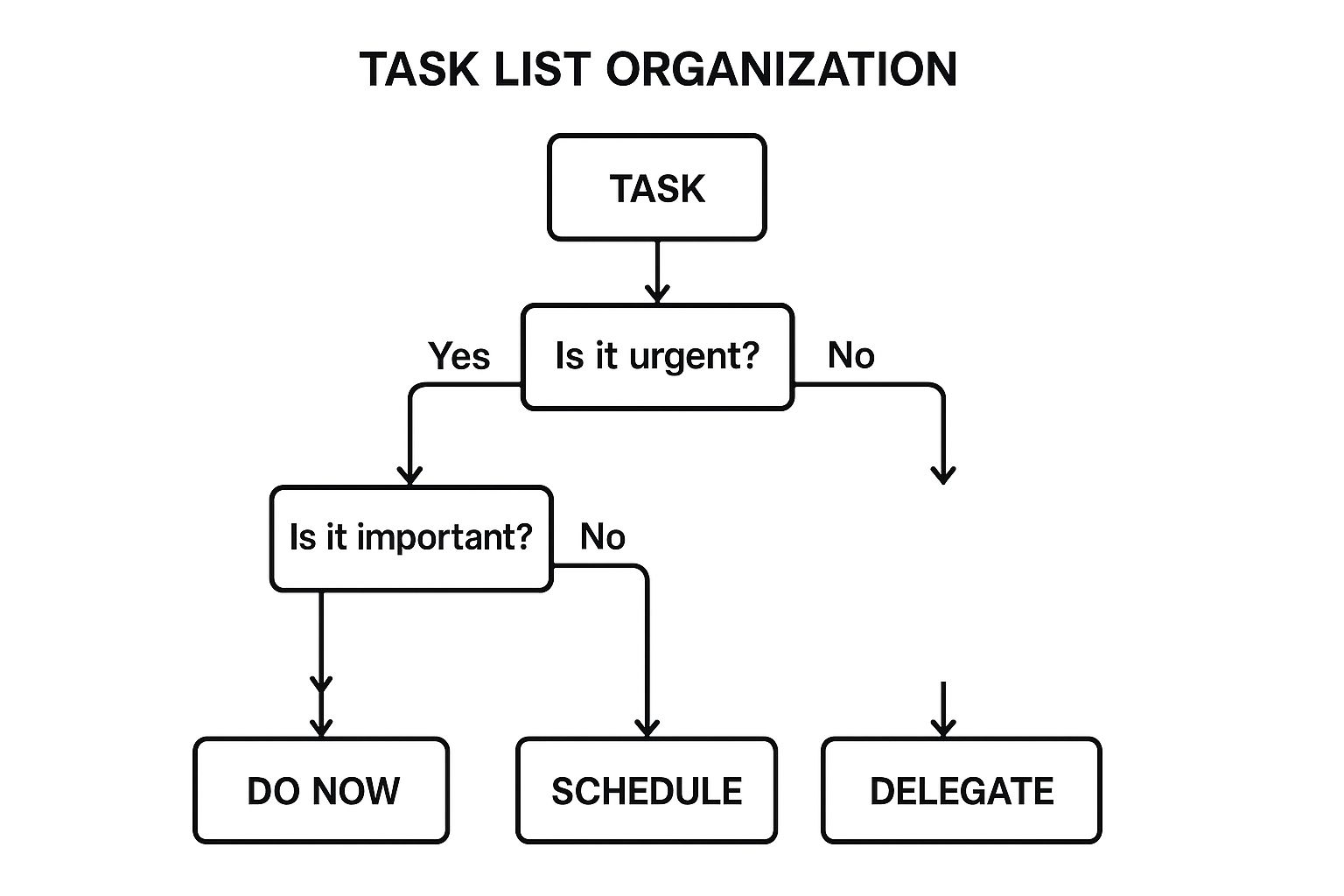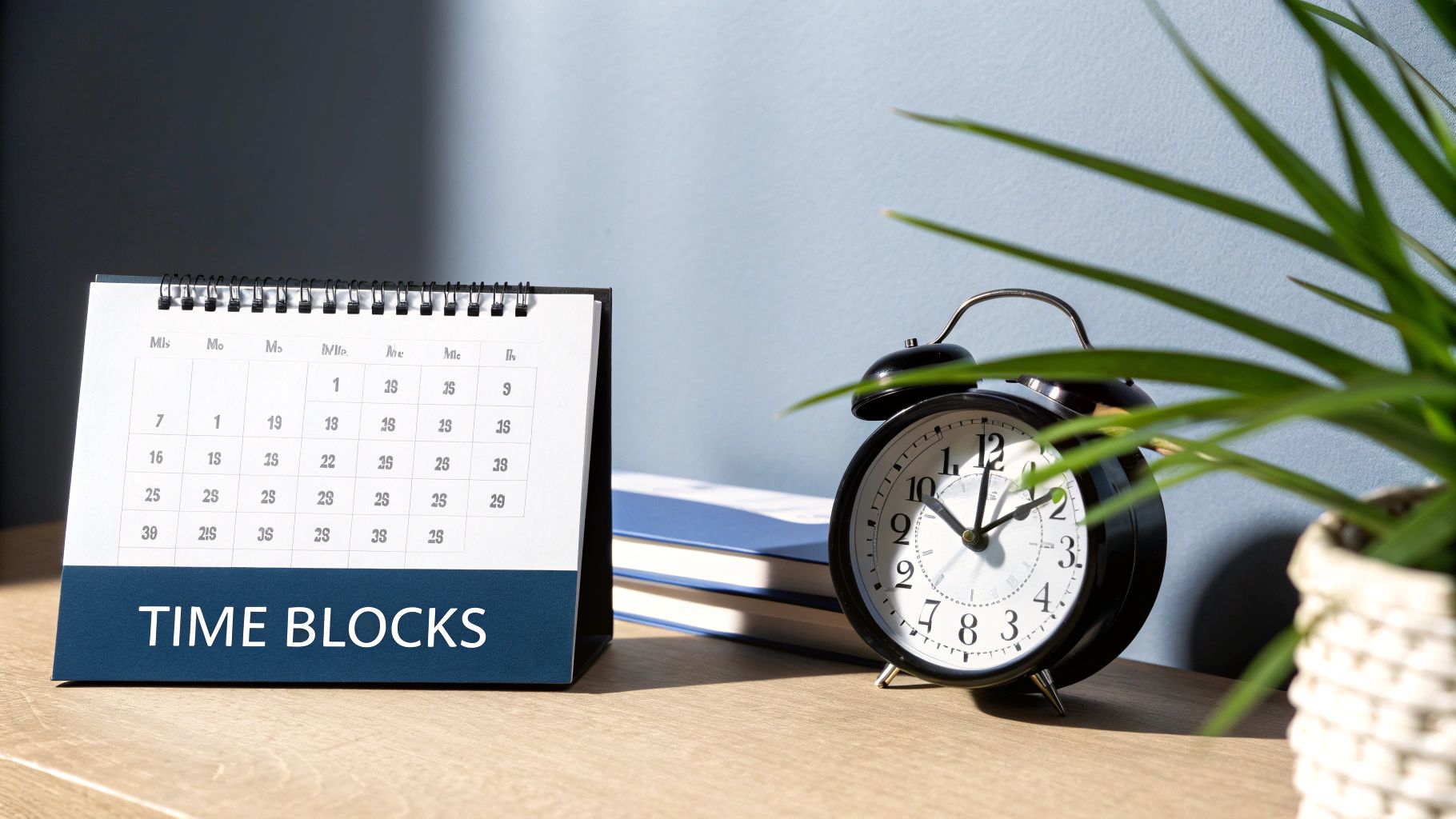
Daily Schedule Planner: Boost Productivity in 6 Easy Steps
Share
Why Your Brain Craves a Daily Schedule Planner

In our fast-paced lives, our brains are constantly processing information. This constant influx can hinder focus and productivity. This is where the daily schedule planner becomes invaluable. While digital tools like calendars and to-do list apps are readily available, physical planners offer unique cognitive benefits.
The act of writing down your schedule creates neural pathways, strengthening memory and commitment. Physically writing your plans makes them more likely to stick. A planner also combats decision fatigue. By outlining your day in advance, you reduce the number of minor decisions you make, preserving mental energy for more crucial tasks.
This pre-planning provides stability and a sense of control. Checking off completed tasks offers a tangible sense of accomplishment, a feeling digital alternatives often miss. This reinforces positive planning habits, encouraging you to maintain your schedule.
The Benefits of Putting Pen to Paper
- Enhanced Memory: Writing solidifies plans and reinforces commitment.
- Reduced Decision Fatigue: Pre-planning frees up mental capacity for important decisions.
- Increased Focus: A structured schedule minimizes distractions, promoting better concentration.
- Tangible Satisfaction: Physically marking completed tasks provides a motivating sense of achievement.
This renewed interest in physical planning is evident in the market. The global diaries and planners market, including daily schedule planners, was valued at approximately $1.15 billion in 2024. Projections indicate significant growth, reaching between $1.6 billion and $3.89 billion by 2033. This growth reflects the increasing demand for organizational tools, especially in North America. More detailed statistics are available in this Diaries and Planners Market Report.
Maximizing Your Planner’s Potential
Struggling to maintain your planner? A regular review can help, much like a website audit. A site audit checklist, used for improving website organization, offers a similar approach for planner maintenance. Periodically reviewing your planning system helps identify areas for improvement.
Consider resources like this guide on How to master your planner. Consistent evaluation is crucial for adapting your planner to your evolving needs. For example, if you consistently find your schedule overbooked, adjust your time estimations and incorporate buffer time. This flexibility ensures your daily schedule planner remains a supportive tool, not a source of stress.
Finding Your Perfect Daily Schedule Planner Match

The decision tree infographic below helps visualize the process of selecting the right daily schedule planner based on individual needs, such as prioritizing daily tasks versus monthly overviews and preferred scheduling flexibility. Not all daily schedule planners are created equal. What works for a busy executive might not be suitable for a student juggling classes and extracurricular activities. Choosing the right planner is the first step towards effective time management and organization. The infographic highlights the key decisions involved in choosing a planner.
Understanding Your Planning Style
The first step in finding the perfect planner is understanding your personal planning style. Are you a meticulous time-blocker who thrives on detailed hourly schedules? Or are you a big-picture thinker who prefers a more flexible approach? This self-awareness is crucial for choosing a planner that supports, rather than hinders, your productivity.
For example, someone who enjoys routine and detailed scheduling might benefit from an hourly planner. This format allows for precise time allocation and provides a clear visual overview of the day. However, this approach could be overwhelming for individuals who prefer a more fluid schedule.
Navigating the Decision Tree
The infographic provides a visual decision tree to guide you through the planner selection process. This tool simplifies identifying the optimal format for your individual requirements. It presents key decision points, leading you to the most suitable planner type based on your responses.
Begin by considering your primary planning focus: daily tasks, weekly goals, or monthly overviews. This initial decision point branches into further questions about your preferred level of detail, scheduling flexibility, and the inclusion of goal-setting features.
Key Decision Points and Outcomes
-
Do you prioritize daily tasks, weekly goals, or monthly overviews? This fundamental question helps narrow the scope of your ideal planner.
-
Do you prefer hourly scheduling or a more flexible approach? This determines the level of detail and structure within your daily plan.
-
Do you need dedicated space for goal setting and reflection? This is crucial for individuals who want to connect their daily actions to larger objectives. You might be interested in: How to master your goals...
To help summarize the different formats, let's look at a comparison table.
To help you choose the right planner format, the table below summarizes the key features, benefits, and ideal user profiles for each type.
Daily Schedule Planner Format Comparison
| Format Type | Key Features | Best For | Limitations |
|---|---|---|---|
| Daily Planner | Focuses on individual days, often with hourly breakdowns. May include sections for to-do lists, appointments, and notes. | Individuals who prefer detailed scheduling and thrive on routine. Ideal for managing daily tasks and appointments effectively. | Can be overwhelming for those who prefer a more flexible approach. May not be suitable for long-term planning. |
| Weekly Planner | Provides a broader view of the week, allowing for planning across multiple days. Often includes space for weekly goals and priorities. | Individuals who prefer to plan their week at a glance. Suitable for managing projects and deadlines that span several days. | May not offer enough detail for those who require hourly scheduling. |
| Monthly Planner | Offers a high-level overview of the entire month. Useful for tracking deadlines, appointments, and important events. | Individuals who focus on big-picture planning and long-term goals. Ideal for managing monthly budgets, tracking deadlines, and scheduling appointments in advance. | May not be suitable for managing daily tasks or detailed scheduling. |
By following the decision tree and considering the table above, you can confidently choose a daily schedule planner that aligns with your planning personality and maximizes your productivity. This ensures your planner becomes a valuable tool for achieving your goals, rather than another abandoned notebook. Remember, the most effective planner is the one you consistently use. Choosing the right format is the first step towards building a sustainable and effective planning practice. Finding the right planner can significantly impact your ability to manage your time effectively and stay organized.
Bridging Paper and Digital: The Hybrid Planning Revolution

The most effective daily schedule planners often blend the tactile satisfaction of pen and paper with the practical advantages of digital tools. This hybrid approach combines the best of both worlds, creating a planning system that is both productive and personally fulfilling. This reflects a larger market trend. Cognitive Market Research estimates the 2023 global diaries and planners market at $1.3 billion, with a projected annual growth of 4.6% through 2030. Daily planners are evolving, integrating physical layouts with digital enhancements like QR codes for seamless calendar synchronization. This serves the growing demand among professionals and students for efficient time management solutions. Learn more about the current diaries and planners market.
Combining the Best of Both Worlds
Many people find that physically writing down their schedules enhances recall and commitment. However, digital calendars offer functionalities like reminders, shared access, and effortless editing that paper planners can't provide. A hybrid system allows you to write your plans in a physical planner and simultaneously sync them with your digital calendar. This offers the cognitive benefits of handwriting combined with the convenient accessibility of digital platforms.
Practical Strategies for Hybrid Planning
One popular hybrid strategy utilizes a QR-enabled planner. These planners typically include a unique QR code for each day. Scanning the code with your smartphone instantly populates your digital calendar with the day's schedule, eliminating redundant data entry. Some planners offer companion apps, allowing you to transfer handwritten notes and tasks to your digital devices seamlessly. This integration simplifies workflow between physical and digital planning tools. An added benefit is the automatic backup system inherent in this approach. Even if your physical planner is lost, your schedule remains safely stored digitally.
Building Your Hybrid System
- Choose a planner: Select a physical planner that aligns with your planning style and offers digital integration options.
- Select your digital tools: Opt for a digital calendar and task management application that you find user-friendly and effective.
- Establish a syncing routine: Create a consistent habit of synchronizing your physical and digital tools. This might involve scanning your daily QR code each morning or transferring your notes every evening. You may also find helpful information in this article: How to master your hybrid system...
By implementing these straightforward steps, you can create a tailored hybrid planning system that meets your specific needs. This integrated method helps maintain focus and structure while maximizing the utility of digital tools. A hybrid system provides a robust and adaptable solution for organization and goal achievement.
Creating Your Bespoke Daily Planning Experience
The age of the one-size-fits-all daily planner is over. Today, personalization is key, allowing you to create a planning system that truly works for you. Instead of adapting to a pre-set template, you can tailor your planner to match your individual needs and preferences, from choosing specific modules to designing a completely unique planning experience.
Personalization: The Key to Consistency
Why is personalization so important? It comes down to forming good habits. When your planning system aligns with your natural workflow, you’re much more likely to use it regularly. Think of it like a well-fitting outfit: comfortable, stylish, and something you feel confident wearing. A personalized planner becomes an integrated part of your thinking, not a chore. This seamless fit encourages consistent use, maximizing the planner's effectiveness.
Customization Options: From Simple Tweaks to Complete Overhauls
The possibilities for customizing your daily schedule planner are extensive. Modular planners offer a straightforward approach for those who prefer simplicity. These systems allow you to add or remove sections as needed. Perhaps you need a dedicated project management section during busy times, which you can later swap for a fitness tracker during a personal training phase.
For maximum personalization, a fully customized planner might be the answer. Independent creators are bringing innovative options to the market. These include customizable layouts and covers, along with specialized sections tailored to specific interests or professions. The daily planner market is evolving toward increased personalization, featuring options like customizable layouts and eco-friendly materials such as recycled paper. Market research shows a growing demand for premium planners priced above $30, catering to niche markets like fitness enthusiasts and recipe collectors, in addition to traditional areas like family planning. You can learn more about this trend by reading this market research.
Adapting Your Planner as Your Needs Evolve
Your ideal daily schedule planner isn’t set in stone. Just as your life and work change, your planning system should adapt as well. Regularly assess your planner’s effectiveness. Are there sections you consistently overlook? Are there missing features you wish you had? Don’t hesitate to try new layouts, planning methods, and even different tools. This ongoing refinement will ensure your planner remains a valuable tool, adapting to your evolving priorities and maximizing your productivity. A planner should be a dynamic resource, not a rigid limitation. By embracing personalization and adaptation, you can create a truly bespoke daily planning experience that empowers you to reach your goals.
Daily Planning Methods That Actually Work

A daily schedule planner, whether digital or paper, is only as effective as the methods used to structure it. Understanding how to maximize your daily productivity is key. This section explores powerful techniques to transform your planner from a simple schedule into a true productivity engine. These methods, drawn from productivity experts and high-performing individuals, offer practical strategies for effective daily planning.
Timeboxing: Your Day in Focused Blocks
Timeboxing involves dedicating specific time slots to individual tasks. It's similar to booking a meeting room—you wouldn't double-book. Timeboxing prevents overlapping commitments and encourages focused work.
For example, you might allocate 9:00 AM to 10:00 AM for writing, 10:00 AM to 11:00 AM for email, and so on. This structure minimizes distractions and promotes deep work. It also provides valuable insight into how you spend your time, making it easier to identify and eliminate time-wasting activities.
The 1-3-5 Rule: Prioritizing for Success
The 1-3-5 rule offers a simple framework for prioritizing tasks. Each day, plan to complete one major task, three medium tasks, and five smaller tasks.
This rule helps you prioritize and prevents your daily schedule from becoming overwhelming. It ensures you focus on high-impact activities while also addressing essential smaller tasks. Your major task might be finalizing a presentation, while smaller tasks could be replying to emails or scheduling calls. This method fosters a balanced approach, acknowledging that not all tasks are created equal.
The Ivy Lee Method: Simplifying Your Priorities
The Ivy Lee Method, a technique over a century old, emphasizes focused prioritization. At the end of each day, identify the six most important tasks for the following day, then rank them by importance.
The next day, work through the list sequentially, finishing one task before starting the next. This method remains remarkably effective. By limiting your focus and working through prioritized tasks, you minimize task-switching and maintain momentum. It also provides a clear plan for the next day, reducing decision fatigue. You might be interested in: How to master planning methods...
Planning Rituals: Setting the Stage for Success
Developing morning and evening planning rituals adds structure to your day. Spend a few minutes each morning reviewing your schedule and setting intentions. In the evening, review accomplishments, adjust your next day's plan, and prepare for a productive start.
These rituals foster a sense of control and maintain planning consistency, making your planner a tool for sustained productivity. They also allow for flexibility, ensuring your plan stays realistic and aligned with your priorities.
Realistic Planning: Working With Your Energy
Effective daily planning considers your natural energy levels. Schedule demanding tasks for peak energy periods and incorporate buffer time between tasks to account for unexpected delays. For many, this means tackling the most challenging tasks in the morning.
This approach maximizes productivity by aligning your work with your peak performance times. It also helps prevent burnout by allowing for breaks and flexibility. Recognizing and incorporating your energy rhythms is essential for creating a sustainable and effective daily plan.
To help you choose a method that suits your needs, here's a comparison of the methods discussed:
Daily Planning Methodologies Comparison A breakdown of popular daily planning techniques with their effectiveness, time commitment, and best applications
| Planning Method | Core Principle | Time Required | Best For | Success Rate (Subjective) |
|---|---|---|---|---|
| Timeboxing | Allocating specific time slots for tasks | Varies based on schedule | Focused work, minimizing distractions | High |
| 1-3-5 Rule | Prioritizing tasks by importance and size | Minimal | Maintaining balance, avoiding overwhelm | Medium |
| Ivy Lee Method | Ruthless prioritization of 6 tasks | Short, daily | Reducing decision fatigue, maintaining momentum | High |
| Planning Rituals | Establishing morning and evening routines | Short, daily | Consistency, adapting to change | Medium to High |
| Realistic Planning | Aligning tasks with energy levels | Ongoing awareness | Preventing burnout, maximizing productivity | High |
By understanding these core principles and their practical applications, you can choose the method, or combination of methods, that best suits your work style and goals. This will enhance your daily planning and lead to greater productivity.
Turning Big Dreams Into Daily Action Steps
A daily schedule planner isn't just about managing your day-to-day activities. It's a powerful tool for achieving your long-term goals. This section explores how to connect your biggest aspirations with your daily actions, turning ambition into tangible progress. It’s about building a system that bridges the gap between your dreams and your daily to-do list.
Goal Cascading: From Vision to Action
Successful goal-setters understand the power of goal cascading. This involves breaking down large, ambitious goals into smaller, more manageable steps. Think of it as a waterfall. The main flow (your annual goal) branches into smaller streams (quarterly objectives), which then feed into even tinier rivulets (weekly focuses and daily tasks).
For example, if your annual goal is to write a novel, your quarterly objectives might be to complete specific chapters. These chapters can then be broken down into weekly writing goals, and finally, daily word counts. This structured approach makes even the most daunting goals feel achievable by providing a clear roadmap for progress.
The Psychology of Progress: Small Wins, Big Motivation
Seeing daily progress towards meaningful goals is incredibly motivating. Each small win reinforces your commitment and provides a sense of accomplishment. This positive feedback loop fuels further action, creating a cycle of progress. When considering various daily planning methods, shifting the focus from time to attention management can be helpful. This involves prioritizing tasks based on their cognitive demands and aligning them with your peak focus periods.
This visibility of progress also dramatically improves follow-through. When you can clearly see how your daily actions contribute to your larger objectives, you're less likely to get sidetracked. Your daily schedule planner becomes a visual reminder of your goals, keeping you focused on what truly matters.
Implementing Goal Cascading in Your Daily Schedule Planner
-
Identify Your Big Goals: Start by defining your overarching goals for the year, or even for the next five years. What do you want to achieve? Where do you see yourself?
-
Break Down Your Goals: Divide your annual goals into smaller, quarterly objectives. Make sure these objectives are SMART: Specific, Measurable, Achievable, Relevant, and Time-bound.
-
Weekly Focus: At the beginning of each week, choose a key area of focus that aligns with your quarterly objectives. This provides a weekly theme to guide your daily actions.
-
Daily Non-Negotiables: Each day, schedule the essential tasks that directly contribute to your weekly focus. These are your non-negotiables—the actions you must complete to move forward.
Examples of Goal Cascading in Action
-
Entrepreneur: Annual Goal: Launch a new product. Quarterly Objective: Develop a marketing plan. Weekly Focus: Create social media content. Daily Non-Negotiables: Write two social media posts.
-
Academic: Annual Goal: Publish a research paper. Quarterly Objective: Complete data analysis. Weekly Focus: Analyze a specific dataset. Daily Non-Negotiables: Dedicate two hours to data analysis.
-
Creative: Annual Goal: Write a screenplay. Quarterly Objective: Outline the first act. Weekly Focus: Develop character backstories. Daily Non-Negotiables: Write one character backstory.
By implementing these strategies, your daily schedule planner becomes more than just a list of tasks; it becomes a powerful tool for achieving your biggest dreams. It transforms daily actions into strategic steps toward a meaningful future, ensuring your efforts are aligned with your aspirations.
Rescuing Your Planning Practice When Life Happens
Life rarely goes exactly as planned. Even the most dedicated planner users encounter disruptions. This section explores the realities of maintaining a daily schedule planner amidst life's unpredictability. We'll discuss how to adapt when your carefully crafted schedule falls apart and how to build resilient planning habits that can withstand real-world pressures.
Adapting to the Unexpected
Unexpected events, like illness, work crises, or major life changes, can throw even the most organized schedule into disarray. The key is to adapt your planning practices, not abandon them. For example, if illness prevents you from following your usual schedule, adjust your priorities. Focus on essential tasks and self-care. This might mean rescheduling less urgent appointments or delegating some responsibilities.
When traveling, your daily schedule planner can still be a valuable tool. Adapt it by including travel-specific information. Add flight times, hotel reservations, and sightseeing plans. Think of your planner as a flexible guide, not a rigid set of rules. This allows you to stay organized while enjoying spontaneous travel moments. You might be interested in: How to master planning techniques for all situations....
Recovering After Planning Lapses
Everyone experiences periods where planning falls by the wayside. The important thing is to recover and get back on track. Don't dwell on missed deadlines or abandoned schedules. Acknowledge the lapse, understand the contributing factors, and create a strategy for resuming your planning practice.
One effective recovery technique is to set aside a short period each day, perhaps 15 minutes, just for planning. This could involve reviewing your goals, updating your schedule, or simply listing tasks for the following day. This small, consistent effort can help rebuild planning momentum.
Maintaining Flexibility While Preserving Structure
A successful daily schedule planner balances flexibility and structure. Structure provides a framework for your day, while flexibility allows you to adapt to the unexpected.
Think of your planner as a roadmap. It guides you toward your destination but allows for detours when necessary. This balanced approach prevents your planner from becoming another source of pressure.
Avoiding the Perfectionism Trap
Perfectionism can hinder consistent planning. Striving for a flawless schedule often leads to frustration and discouragement, making it easier to give up on planning altogether. Remember, the goal is progress, not perfection.
Imagine a gardener tending a garden. Some days the weeds grow faster than the flowers. The gardener doesn't give up. They keep weeding, knowing that consistent effort is key to a thriving garden. Likewise, a few missed tasks or unplanned days don't negate the benefits of using a daily schedule planner. Focus on consistency.
Building Resilient Planning Habits
Building resilient planning habits means integrating your planner into your daily routine. This might involve setting a specific time for planning each day, keeping your planner visible, or using it to store all your appointments, tasks, and notes.
By making these practices habitual, your planner becomes an automatic part of your workflow, increasing consistent use. Resilient planning also involves regular review and adjustments to ensure its effectiveness and prevent it from becoming a source of stress.
Ready to take control of your schedule and boost your productivity? Explore the Boss Personal Planner and discover the perfect planning solution for your needs. Visit Boss Personal Planner now and start planning for success.
